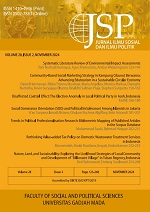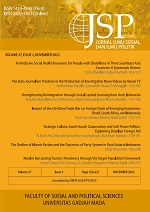Promises, Projects, and Power: Italy and Indonesia Elites in the Belt and Road Initiative
Matteo Piasentini(1), Aniello Iannone(2*)
(1) Department of Political Science, University of The Philippines Diliman, Philippines
(2) Department of Government and Political Science, Universitas Diponegoro, Semarang, Indonesia
(*) Corresponding Author
Abstract
This research examines the political and economic dynamics of Italy and Indonesia in relation to their engagement with China's Belt and Road Initiative (BRI). Drawing from the theoretical tradition of state instrumentalism and recent conceptualisations of the “infrastructure state” as an emerging global phenomenon, we argue that initiatives such as the BRI do serve the purposes of political elites in both the developing and developed world. The comparative analysis between the two dissimilar countries, Italy and Indonesia, reveals the existence of a broader global trend. Both experience democratic backsliding while strategically engaging with the BRI to meet their infrastructural needs and political objectives. This study contributes to understanding how domestic political dynamics and external economic opportunities intersect in shaping the developmental trajectories of middle-power states within the global geopolitical landscape.
Keywords
Full Text:
PDFReferences
Addessi, D. (2020). Le grandi opere. In Industria, Italia (pp. 141-156). Editrice Sapienza.
Albertazzi, D., Giovannini, A., & Seddone, A. (2018). No regionalism please, we are Leghisti !’ The transformation of the Italian Lega Nord under the leadership of Matteo Salvini. Regional & Federal Studies, 28(5), 645–671. https://doi.org/10.1080/13597566.2018.1512977
Amighini, A. (2019, March 15). Italia-Cina: quel Memorandumèun pasticcio. Internazionale. https://lavoce.info/archives/58076/italia-cina-quel- memorandum-e-un-pasticcio/
Aspinall, E., & Mietzner, M. (2019). Southeast Asia's Troubling Elections: Nondemocratic Pluralism in Indonesia. Journal of Democracy, 30(4), 104-118. https://dx.doi.org/10.1353/jod.2019.0055
Aswicahyono, H., & Friawan, D. (2007). Infrastructure development in Indonesia. International Infrastructure Development in East Asia–Towards Balanced Regional Development and Integration. ERIA Research Project Report, 2. ISO 690
Aufiya, M. A. (2017). Indonesia’s global maritime fulcrum: Contribution in the Indo-Pacific Region. Andalas Journal of International Studies (AJIS), 6(2), 143-158.
Bobba, G. & McDonnell, D. (2015). Italy–A Strong and Enduring Market for Populism.
Bu, Qingxiu (2021). State capitalism and global governance under the belt and road initiative. https://sussex.figshare.com/ articles/chapter/State_capitalism_and_ global_governance_under_the_belt_and_ road_initiative/23490977?file=41199455
Camba, A. A. (2020). Derailing Development: China’s Railway Projects and Financing Coalitions in Indonesia, Malaysia, and the Philippines. Global Development Policy Center. https://doi.org/10.13140/RG.2.2.30135.14243.
Chen, J. Y. W. (2022). Reconciling different approaches to conceptualizing the glocalization of the Belt and Road Initiative projects. Globalizations, 19(7), 1165–1177. https://doi.org/10.1080/14747731.2022.2062843
Chryssogelos, A. (2017) Populism in foreign policy. In Oxford Research Encyclopedia of Foreign Policy Analysis. Oxford: Oxford University Press.
Colven, E. (2017). Understanding the allure of big infrastructure: Jakarta's great garuda sea wall project. Water Alternatives, 10, 250-264.
Cox, R. W. (1981). Social Forces, States and World Orders: Beyond International Relations Theory. Millennium, 10(2), 126-155. https://doi.org/10.1177/03058298810100020501
Crocenzi, F. (2009). The Italian hub. La Penisola tra l'Europa e la nuova Via della Seta. Rubbettino Editore.
Damuri, Y. R., Perkasa, V., Atje, R., & Hirawan, F. (2019). Perceptions and Readiness of Indonesia towards the Belt and Road Initiative.
De Cecco, M. (2009). Eppure, non si muove: Legal change, institutional stability and Italian corporate governance. In M. Bull & M. Rhodes (Eds.), Italy - A contested polity (1st ed.). Routledge.
Destradi, S., Cadier, D., & Plagemann, J. (2021). Populism and Foreign Policy: A Research Agenda (Introduction). Comparative European Politics, 19(6), 663-682. https:// doi.org/10.1057/s41295-021-00255-4
Di Quirico, R. (2010). Italy and the global economic crisis. Bulletin of Italian Politics, 2(2), 3-19.
Economic Times (2023). What is China's Belt and Road Initiative?. https://economictimes.indiatimes.com//news/international/us/what-is-chinas-belt-and-road-initiative/articleshow/104475631.cms?utm_source=contentofinterest&utm_ medium=text&utm_campaign=cppst
Eickhoff, M., van Klinken, G., & Robinson, G. (2017). 1965 Today: Living with the Indonesian Massacres. Journal of Genocide Research, 19(4), 449–464. https://doi.org/10.1080/14623528.2017.1393931
Engler, P., & Klein, M. (2017). Austerity measures amplified crisis in Spain, Portugal, and Italy. DIW Economic Bulletin, 8, February 22, 2017.
Fakih, F. (2020). Authoritarian modernization in Indonesia’s early independence period: The foundation of the New Order State (1950-1965) (p. 314). Brill.
Geopop. (2021). Effetto Nimby: Quando le com unità ins orgono c ontro opere e infrastrutture. https://www.geopop.it/effetto-nimby-quando-le-comunita-insorgono-contro-opere-e-infrastrutture/
Ghiretti, F. (2021). The Belt and Road Initiative in Italy: The ports of Genoa and Trieste (IAI Papers 21/17). Istituto Affari Internazionali.
Gold, D. A., Clarence Y. H., & Wright, E.O. (1993). Marxist Theories of the Capitalist State. In M. E. Olsen, M. N. Marger, & V. Fonseca (Eds.), Power in modern societies (pp. 330-341), Westview Press.
Golden, M., & Picci, L. (2005). Corruption and the management of public works in Italy (Version 2.1). University of California at Los Angeles, University of Bologna. https://bit.ly/3M8HJZz
Italian Government (2019). Memorandum of Understanding between the Government of the Italian Republic and the Government of the People's Republic of China on Cooperation within the Framework of the Silk Road Economic Belt and the 21st Century Maritime Silk Road Initiative. https://www.governo.it/sites/governo.it/ files/Memorandum_Italia-Cina_EN.pdf.
Kompas.com. (2014, May 21). Nawa Cita", 9 agenda prioritas Jokowi-JK. Kompas. com. https://nasional.kompas.com/read/2014/05/21/0754454/.Naw a. Cita.9.Agenda.Prioritas.Jokowi-JK
Kuik, C. C. (2021). Asymmetry and Authority: Theorizing Southeast Asian Responses to China's Belt and Road Initiative. Asian Perspective, 45(2), 255-276.
Lampton, D. M., Ho, S., & Kuik, C. C. (2020). Rivers of iron: Railroads and Chinese power in Southeast Asia. University of California Press.
Lenti, R. T. (2016). [Review of Riforme, ripresa, rilancio. Europa e Italia, by M. Fortis & A. Q. Curzio]. Il Politico, 81(1(241)), 168–170. http://www.jstor.org/stable/45426496
León, M., Pavolini, E., & Guillén, A. M. (2015). Welfare Rescaling in Italy and Spain: Political Strategies to Deal with Harsh Austerity. European Journal of Social Security, 17(2), 182-201. https://doi.org/10.1177/138826271501700203
Lucchesi, F. (2018). Non solo strade: l’imponente sistema di infrastrutture e comunicazioni intermodali finalizzate alla realizzazione della Nuova Via della Seta. Geography Notebooks, 1(1), 27-41
Mackie, J. A. C. (1983). Property and Power in New Order Indonesia.
Marciano, C., Idone Cassone, V., & Magnani, N. (2022). Il populismo nelle regioni alpine tra nativis mo e bis ogno di riconoscimento: Il caso della Lega Nord in Trentino e Valle d'Aosta. Sociologia urbana e rurale, 44(127), 154-175. Franco Angeli. http://digital.casalini.it/10.3280/ SUR2022-127012
Mietzner, M. (2020). Authoritarian innovations in Indonesia: electoral narrowing, identity politics and executive illiberalism. Democratization, 27(6), 1021-1036.
Miliband, R. (1969). The state in capitalist society. New York: Basic Books.
Miliband, R. (1993). The state system and the state elite. In M. E. Olsen, M. N. Marger, & V. Fonseca (Eds.), Power in modern societies (pp. 341-351), Westview Press.
Mosca, L. (2014). The Five Star Movement: Exception or Vanguard in Europe?. The International Spectator, 49(1), 36–52. https://doi.org/10.1080/03932729.2013.875821
Mosca, L. (2015). The Movimento 5 Stelle and social conflicts: Between symbiosis and cooptation. In F. Tronconi (Ed.), Beppe Grillo's Five Star Movement: Organisation, communication and ideology (1st ed., pp. 254). Routledge. https://doi.org/10.4324/9781315569062
Mosca, L., & Tronconi, F. (2021). Beyond left and right: The eclectic populism of the Five Star Movement. In Varieties of populism in Europe in times of crises (1st ed., pp. 26). Routledge. https://doi.org/10.4324/9781003157380
Mudde, C. (2017). Populism: An ideational approach. In C. Rovira Kaltwasser, P. Taggart,P.OchoaEspejo,&P.Ostiguy(Eds.), The Oxford handbook of populism. Oxford Handbooks. https://doi.org/10.1093/oxfordhb/9780198803560.013.1
Negara, S. D. (2016). Indonesia’s infrastructure dev elopment under the Jokowi administration. Southeast Asian Affairs, 145-166.
Negara, S. D., & Suryadinata, L. (2019). China’s Maritime Silk Road Initiative and Indonesia. China's Maritime Silk Road Initiative and Southeast Asia: Dilemmas, Doubts, and Determination, 65-94.
Salim, W., Negara S. D. (2016). Why is the High-Speed Rail Project so Important to Indonesia. ISEAS Perspective. https:// www.iseas.edu.sg/images/pdf/ISEAS_ Perspective_2016_16.pdf.
Paendong, M. W. (2020, December 3). The Jakarta-Bandung rail project: 5 years on and still going nowhere. The Diplomat. https://thediplomat.com/2020/12/the-jakarta-bandung-rail-project-5-years-on-and-still-going-nowhere/
Pasquino, G. (2007). The Five Faces of Silvio Berlusconi: The Knight of Anti-politics. Modern Italy, 12(1), 39–54. https://doi.org/10.1080/13532940601134817
Passarelli, G., & Tuorto, D. (2022). From the Lega Nord to Salvini’s League: changing everything to change nothing?. Journal of Modern Italian Studies, 27(3), 400–415. https://doi.org/10.1080/1354571X.2022.2044649
Pedrazzani, A. (2018). Introduction to the special issue: ‘Governo del cambiamento’?. Italian politics under the yellow-green government. Italian Political Science, 13(2).
Pisu, M. (2010). Tackling the infrastructure challenge in Indonesia.
Poggetti, L. (2019, March 21). Italy’s BRI blunder. Project Syndicate. https://www.project-syndicate.org/commentary/italy-endorsement-of-china-bri-big-mistake-by-lucrezia-poggetti-2019-03
Power, T. P. (2018). Jokowi’s authoritarian turn and Indonesia’s democratic decline. Bulletin of Indonesian Economic Studies, 54(3), 307-338.
Pugliese, G. (2020). Italy and China: Much ado about an MOU (EAI Background Brief No. 1565). East Asian Institute, National University of Singapore.
Pugliese, G., Ghiretti, F. & Insisa, A. (2022). Italy's embrace of the Belt and Road Initiative: populist foreign policy and political marketing. International Affairs, 98(3), 1033-1051. https://doi.org/10.1093/ia/iiac039
Roosa, J. (2006). Pretext for Mass Murder: The September 30th Movement and Suharto's Coup d ‘Etat in Indonesia, Madison: University of Wisconsin Press.
Roux, C. & Verzichelli, L. (2010). Italy: Still a Pro-European, but not a Fully Europeanised Elite?. South European Society and Politics, Taylor & Francis Journals, 15(1), 11-33.
Satrio, A. (2018). Constitutional Retrogression in Indonesia under President Joko Widodo's Government: What Can the Constitutional Court Do?. Const. Rev., 4, 271.
Schindler, S., & DiCarlo, J. (2022). The rise of the infrastructure state: How US– China rivalry shapes politics and place worldwide. Bristol University Press, pp. 1-13.
Schindler, S., & Kanai, J. M. (2021). Getting the territory right: Infrastructure-led development and the re-emergence of spatial planning strategies. Regional Studies, 55(1), 40-51. https://doi.org/10.1080/00343404.2019.1661984
Serapioni, M., & Hespanha, P. (2019). Crisis and austerity in Southern Europe: Impact on economies and societies/Crise e austeridade no Sul da Europa: impacto nas economias e sociedades. e-cadernos CES, 31. https://doi.org/10.4000/eces.4068
Shi, W., & Min, Y. (2021). Chinese capital goes global: The Belt and Road Initiative and beyond. Journal of East Asian Studies, 21(2), 173-192.
Sriyanto, N. (2018). Global maritime fulcrum, Indonesia-China growing relations, and Indonesia’s middle powermanship in the East Asia region. Jurnal Kajian Wilayah, 9(1), 1-19.
Szczerbiak, A., & Taggart, P. (2024). Euroscepticism and anti-establishment parties in Europe. Journal of European Integration, 46(8), 1171–1191. https://doi.org/10.1080/07036337.2024.2329634
Ross Tapsell. (2015). Indonesia’s Media Oligarchy and the “Jokowi Phenomenon.” Indonesia, 99, 29–50. https://doi.org/10.5728/indonesia.99.0029
Taufik, T., Noor, M. N. M., & Hamil, J. (2023). The Elite Construction Post- Authoritarianism Suharto. Malaysian Journal of Social Sciences and Humanities (MJSSH), 8(6), e002335-e002335.
Tritto, A. (2020). Contentious embeddedness: Chinese state capital and the Belt and Road Initiative in Indonesia. Made in China Journal, 5(1), 182-187.
Vannucci, A. (2016). The "clean hands" (mani pulite) inquiry on corruption and its effects on the Italian political system. 1.1 Articolo in rivista. CINECA IRIS Institutional Research Information System.
Verzichelli, L., Marino, B., Marangoni, F., Russo, F. (2022). The Impossible Stability? The Italian Lower House Parliamentary Elite After a “Decade of Crises”. Frontiers in Political Science, 4. https://doi.org/10.3389/fpos.2022.790575.
Wahanisa, R., Hidayat, A., Riyanto, R. B., & Anggono, B. D. (2021). Problems of disputes/conflicts over land acquisition towards development for public interest in Indonesia. International Journal, 10, 321.
Wang, Z. (2023). Infrastructure and politics: Why the Belt and Road Initiative proceeded differently in Malaysia and Indonesia. Asia Pacific Viewpoint, 64(2), 144-157.
Warburton, E., & Aspinall, E. (2019). Explaining Indonesia’s democrat ic reg ression. Contemporary Southeast Asia, 41(2), 255-285.
Wetherly, P. (2008). Can capitalists use the state to serve their general interests? In P. Wetherly, C. W. Barrow, & P. Burnham (Eds.), Class, power and the state in capitalist society: Essays on Ralph Miliband (pp. [page range]). Palgrave Macmillan.
Winters, J. A. (2013). Oligarchy and democracy in Indonesia. Indonesia, 96(1), 11-33.
World Bank (2019). Belt and Road Economics: Opportunities and Risks of Transport Corridors. Washington, DC: World Bank. License: Creative Commons Attribution CC BY 3.0 IGO.
Yeremia, A. E. (2021). Explaining Indonesia's constrained eng ag ement with t he Belt and Road Init iat ive: Balancing developmentalism against nationalism and Islamism. Asian Perspective, 45(2), 325-347.
Yifu L. J. & Wang, Y. (2013). Beyond the Marshall Plan: A Global Structural Transformation Fund. Subm itted to the High-L evel Panel on the Post-2015 Development Agenda. https://www.post2020hlp.org/ wp-content/uploads/docs/Lin-Wang_ Beyond-the-Marshall-Plan-A-Global- Structural-Transformation-Fund.pdf.
Article Metrics
Refbacks
- There are currently no refbacks.
Copyright (c) 2025 Jurnal Ilmu Sosial dan Ilmu Politik

This work is licensed under a Creative Commons Attribution-ShareAlike 4.0 International License.























